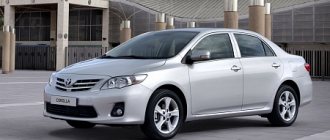Over the past 10-15 years, Japanese and Korean cars have demonstrated total superiority in the segment of inexpensive sedans. Toyota Corolla is generally considered the leader in global sales, but Kia Rio is also confidently building up its muscles, which can be observed when assessing sales dynamics in the Russian market.
The cars are not exactly classmates: the Korean is a typical representative of the C segment, the Corolla belongs to the C+ class. So what should you give preference to, time-tested Japanese reliability or the assertiveness of Rio, which takes its toll on technology and practicality?
This is what we have to find out.
Technical features of the models
First, let's compare the basic technical characteristics of cars (Kia Rio model 2021 with a 1.6-liter engine and automatic transmission, Toyota Corolla 11th generation 2021 with the same engine and manual transmission):
| Kia Rio | Toyota Corolla | |
| Country of assembly | RF | Türkiye |
| Engine volume, l. | 1,59 | 1,598 |
| Power, l. With. | 123 | 122 |
| Max cr. torque at rpm Nm | 150/4850 | 158/5200 |
| Transmission type | Six-speed automatic transmission | Six-speed manual transmission |
| Fuel tank volume, l. | 50 | 56 |
| Length, cm | 440 | 463 |
| Height, cm. | 147,0 | 146,5 |
| Wheelbase, see | 260 | 270 |
| Clearance, see | 16,0 | 15,0 |
| Weight in running order, i.e. | 1,197 | 1,375 |
| Trunk volume, l. | 480 | 450 |
| Fuel consumption, combined cycle | 6,5 | 6,6 |
| Tire size | 185/65R15 | 205/55R16 |
Comparison
The length of the Toyota Corolla is 20 cm longer than the Kia Rio, while the trunk is 30 liters smaller, and the tank volume, on the contrary, is 5 liters larger. Accordingly, due to the large longitudinal dimensions, more space is achieved for passengers in the Toyota Corolla cabin, increasing the comfort of travel. On the other hand, the Kia Rio has a larger trunk, and its shorter length allows it to be more maneuverable in confined city spaces.
The Kia Rio has a slightly higher ground clearance - 16 cm , and the Toyota Corolla - 15 cm . Thus, the Kia Rio is also better suited for country driving.
The Kia Rio can rightfully be called a family people's car, while the Toyota Corolla is a business class car.
Exterior
After restyling, Rio appeared in a new guise: the headlights changed their shape, becoming more voluminous, the hood was lowered to ensure the safety of pedestrians, which is why the car became squat. There are obvious efforts by designers to make the look more European and modern. This was partly successful - the radiator grille acquired a chrome edging, the air intake became more massive, and optics with running lights appeared at the stern, stretching along the entire length of the trunk lid. And still, many people confuse Rio with Cerato. But this is more likely to be good than bad.
As for the Corolla, it was also unlucky with identification, thanks to the presence of an older brother - Camry. But there is no need to talk about some kind of accident here: the Japanese deliberately tried to achieve a certain similarity with another world bestseller. Among the changes that appeared after the next restyling, one can note the appearance of running lights at the front and rear, a decrease in the amount of chrome, and rounded corners of the front/rear bumpers. The appearance of the sedan has become more rapid and is perceived holistically; in a sense, the car even looks like a liftback.
Story
Toyota Corolla is a legendary compact car that has been on the market since 1966. In 1974, the Corolla was included in the Guinness Book of Records as the best-selling car. As of 2000, a total of over 25 million Corolla units were sold, and in 2013 this figure exceeded 40 million cars.
To date, the Japanese have already presented eleven generations, the last of which was presented in May 2012. In 2012, developers recalled 7,400,000 vehicles due to possible electrical failures.
Kia Cerato seems like just a “youngster” compared to today’s counterpart, since it hit the market only in 2003. Interestingly, in Italian “Cerato” is translated as “shiny”, “waxed”. So, the debut version of the model was produced only at Korean enterprises, from where it was supplied to Europe and the USA.
In 2008, a presentation of the second generation Cerato took place in Sydney, sales of which began in the CIS in March 2009. In 2013, Cerato 3 was presented to the public in Los Angeles, which received a new design that corresponds to the company’s new corporate policy.
Since Corolla is much older than his opponent, it is the “Japanese” who gets the advantage in this regard. Although it is possible that in the future the situation will change dramatically.
Salon and trunk
The interior of the new Corolla cannot be confused with any other. The absence of a smooth transition of the central panel into the tunnel is rare today, but it is even rarer to see a standard 7-inch touchscreen display, which rises a good 3 inches on the dashboard. However, this is the prerogative of not the cheapest trim levels (starting from the Comfort version).
Toyota Corolla car interior
One can also note an improvement in the quality of finishing materials, but without a large screen, the interior looks spartan, the ambience is varied only by the “propellers” of the deflectors, which are clearly taken from Audi.
The ergonomics of the driver's seat cannot be called without shortcomings. So, in order to use the seat heating buttons, you need to lift the lid of the box located on the center console. To turn on the heated steering wheel, you have to tilt in the opposite direction - these keys are located to the left of the steering wheel.
In Cerato, both of these groups of buttons are concentrated in one place, near the automatic transmission selector handle. The voluminous niche with connectors for the multimedia system is covered with a curtain, which can be used as a dining table. The quality of the Korean's plastic is traditionally high, visually better than that of the Corolla. Thanks to this, the Rio's interior is generally perceived as more expensive. Kia's ergonomics are also excellent, but there is also a drawback - rather wide pillars, which impair front visibility. But this is done for the sake of passive safety. Another reason for criticism is insufficient ventilation of the cabin, when the air is damp, the windows sweat even when the car's air conditioning is turned on.
Due to the Rio's low stance, tall drivers will experience some discomfort. There are no complaints about the seats, although for some they will be a little high, and trying to lower them leads to the fact that only the back of the seat lowers, and you simply fall back, although your knees remain at the same level.
The Corolla has no such problems. However, the doorway cannot be called comfortable either - the landing here is like in a crossover, you need to be careful not to injure your head.
If the Japanese driver's seat profile and adjustments are good, then the steering wheel reach is insufficient, and this problem cannot be solved. The Japanese sofa in the back is much more comfortable, although it is slightly narrower and there is no seat heating. The front seats are comfortable without any reservations, the pronounced lateral support and the length of the backrest are optimal for drivers with any anthropometry. Everything is spoiled only by the fact that the steering wheel is pressed against the dashboard, which forces you to lean or move forward, which will strain small drivers. Having adjustable lumbar support would not hurt, but the Rio doesn’t have it either – it’s in the wrong segment. So it is not possible for the driver to take the most comfortable position in both cars.
A comparison of Toyota Corolla and Kia Rio in terms of passenger convenience is unlikely to reveal a clear favorite. The width of the sofa is the Korean one in front, and the floor here is flatter, so three adults will be quite comfortable here. But there is less knee room than the Toyota - this is due to the short wheelbase, and on top, one might say, there is no space at all. The gap between the floor and the front seats is also narrow; the quality of the sofa filling is reminiscent of the seats of an electric train. But the possibilities for transforming the interior are better here than in the Japanese.
Kia Rio car interior
But Toyota also has more than enough space in the back, especially between the sofa and the front seat - in this regard, the Corolla is second only to the RAV4, which is considered the undisputed leader in the crossover segment. There is also no shortage of free space overhead, but the lack of heating and airflow is disappointing. And for some unknown reason, the center armrest is tilted forward, so you need to be very careful with drinks here. An undoubted advantage of the Corolla interior is the ability to choose a color option, dark or light. The latter looks very impressive, without being practical.
Engines and transmissions
The Japanese sedan is equipped with four power units: a 99-horsepower 1.3-liter, a 90-horsepower 1.4-liter diesel engine, a base 122-horsepower 1.6-liter engine and a 140-horsepower 1.8-liter engine. Toyota does not supply cars with diesel units to Russia as a matter of principle, but in this case there is discrimination even on the most extreme engines, so at present our car enthusiasts have to be satisfied with a 1.6-liter unit.
Rio has half the range of engines, but our country is supplied with configurations with both engines: a 100-horsepower 1.4-liter and a 123-horsepower 1.6-liter.
As for transmissions, the Corolla has three: a five- or six-speed manual and a CVT. Kia is equipped with either a six-speed manual transmission or a six-speed automatic transmission.
What's better? Comparison of Kia Rio and Toyota Corolla in terms of engine + transmission combination is in favor of the Korean: here there is a choice of engines, and instead of the CVT, which is unloved by our compatriots, there is an automatic transmission.
Car interior
In the cabin of both vehicles, the driver and passengers will feel comfortable.
Toyota uses high-quality plastic trim. There are cup holders and an armrest for the driver. The dashboard on a Japanese car is made as ergonomically and reliably as possible.
Heated front glass is present only in the rest zone of the wipers. The Corolla chairs are upholstered with good wear-resistant material.
The creation of the Korean automobile industry can boast of having a lot of little things for the convenience of the driver. Special mention should be made of the steering wheel adjustment for reach and height.
The dashboard trim material is inexpensive matte plastic. The seat upholstery is made of wear-resistant fabric in simple configurations and leatherette in the Premium version of the car.
Dynamics, fuel consumption
Both sedans take off quickly from a standing start. But for the Japanese, further acceleration occurs quite confidently and predictably thanks to the operation of the variator, which is sensitive to changes in the fuel supply, while the Rio, with the transition to second gear, loses in dynamics, requiring active throttle. Each press of the accelerator pedal is accompanied by a lower step and a noticeable push.
Kia Rio car
In short, the operation of the Rio automatic transmission cannot be called ideal: it behaves roughly, especially in active driving mode, so drivers will definitely not like it. But there is an alternative - a manual transmission, which is devoid of all these disadvantages and is available in most trim levels.
In Corolla, manual transmission is available only on budget versions, and the continuously variable transmission is also not ideal. Even when you turn on the sports mode, the acceleration dynamics will not please you, since the electronics will first force the engine to increase speed, and only then the car will begin to accelerate, changing the gear ratio.
Despite this, the Japanese accelerates more vigorously. The only negative of the variator is that at high speeds it starts to buzz unpleasantly.
We propose to compare the speed qualities of cars depending on the engine + transmission combination:
| Rio 1.4MT | Rio 1.4AT | Rio 1.6MT | Corolla 1.3MT | Corolla 1.6MT | Corolla 1.6 AT | |
| Max speed | 190 | 176 | 190 | 180 | 193 | 183 |
| Acceleration to “hundreds” seconds | 11,5 | 13,4 | 10,3 | 13,2 | 10,4 | 11,8 |
| Consumption city | 7,6 | 8,4 | 7,9 | 7,3 | 4,8 | 5,8 |
| Route | 4,9 | 5,2 | 4,8 | 8,9 | 5,7 | 6,9 |
| Average | 5,9 | 6,4 | 6,1 | 9,3 | 6,0 | 7,2 |
Controllability and safety
Driving a Corolla is much more comfortable than a Japanese one. Although at first it may seem that the steering wheel is too light, on a high-speed straight track the Japanese holds the trajectory perfectly - there are no yaw phenomena. When entering high-speed turns, the driver receives through the steering wheel all the necessary information about the angles of rotation of the front wheels. In a sense, the behavior of the Toyota Corolla when cornering can even be called moderately reckless. A change in trajectory is perceived by the car easily; the suspension is able to cope with lateral loads quite well, without noticeable rolls, showing slight redundancy on steep arcs. When the coefficient of adhesion of the tires to the road surface falls below a critical limit, sliding off the trajectory occurs, but only with the front wheels. It feels unusual, but without consequences, which is very important for a family car.
As for the Corolla's brakes, they are moderately responsive, providing excellent feedback from the pedal, but without being too sharp or eager.
Toyota Corolla
Rio's brakes clearly lack this information content. The sporty algorithm of the pedal operation helps out: braking is carried out more effectively not so much by the pedal stroke as by the applied force, and you quickly get used to it.
The Kia driver won't be too pleased with the steering feedback either. Despite the painstaking work of reconfiguring the electric booster, performed during the last restyling of the sedan, the level of information content of the steering wheel has increased very little, so one can only dream of complete control over the behavior of the car. The steering wheel is very light when driving at low speeds, but as the car accelerates it becomes increasingly heavier, trying to take the zero position with manic persistence. And only after reaching the threshold of 120 km/h, control becomes easy again. The Korean's behavior in high-speed turns is in many ways reminiscent of computer simulators: he turned the steering wheel - the picture on the monitor sharply shifted to the side, turned the steering wheel in the opposite direction - the picture leveled out.
In the presence of even slight rutting on a flat asphalt road, yaw phenomena are present, but the amplitude of the displacement does not extend beyond the boundaries of the lane, being limited by the relief of the rut. It’s unpleasant, but on the pre-restyling Rio the situation was even worse.
The comfort of the Kia suspension is at an average level. If the quality of the road surface is acceptable and the size of the defects does not exceed 5 centimeters, then you will practically not feel them. But with more serious problems, the Korean’s suspension will work much worse, missing a large number of impacts.
Toyota Corolla car suspension
The presence of gentle waves is fraught with vertical rocking; joints on asphalt or concrete respond with knocking and small unpleasant impacts. The Rio's suspension is too short-travel and simply does not have time to rebound, so deep holes are fraught with the failure of almost the entire sedan body. Since Kia's 215/45R17 tires are low-profile, their travel is also not enough to significantly absorb the impact energy when hitting large bumps. What can we say about dirt roads - a car drives along them as if on sleepers, so it’s better to forget about forays into nature in early spring or autumn. In a word, the comfort of the Rio suspension raises a lot of questions, and the Koreans have some work to do to correct the situation in future versions.
The Toyota chassis is much more attractive in this regard - it is not so afraid of broken roads, and the suspension does a good job of eliminating the consequences of hitting uneven roads. The impact is partially softened by energy-intensive shock absorbers, but a significant portion of the impact energy is absorbed by plump 205/55R16 tires. But if instead of the original tires you use 15-inch ones with a 65% profile, then driving on our roads will be much quieter and more comfortable.
As a result of the latest restyling, the noise absorption coefficient of Toyota's wheel arches has increased noticeably, so driving on a road with fine gravel terrain no longer makes you feel like you are near an alarmed swarm of bees. But external noise still penetrates into the cabin, especially if the road is wet after rain. In the Rio, the situation with noise absorption is slightly better, but shortcomings with aerodynamics are reflected in the howling of the wind at high speeds, especially in the area of the A-pillars.
Suspension Kia Rio
Appearance
At first glance, it may seem that the Cerato and Corolla are completely different in appearance, but if you look closely, you will notice a certain sparkle in both models that makes them attractive. The exterior of both cars looks very bright and dynamic. Cerato's main focus is on solidity and presence, while Corolla's is on sportiness and progressiveness.
From the front, the cars are similar, except for the presence of false radiator grilles that are completely different in structure, and differences in the hoods, which are completely smooth on the Japanese car.
The cars are also similar from the side. Similarities can be found everywhere: in the contours of the roof, in the curves of the body, in the shape of profile stampings, and so on.
The situation is similar at the rear - there are very few differences.
Despite the equality in many aspects, I would like to give a slight advantage to the exterior of the Kia Cerato.
Options and prices
The cost of a car is a relative concept: even monthly price fluctuations in absolute terms can have a decent amplitude, let alone annual ones. However, this information will be useful not only when it is fresh, but also from the point of view of comparing the proportions of the cost of various trim levels.
We provide data on the trim levels and costs of the compared cars at the beginning of 2021. Let's start with the Kia Rio (price is indicated in rubles):
- Classic with a 1.4-liter engine and manual transmission – 765,000;
- Classic Audio (1.4/manual transmission) – 799,990;
- Comfort (1.4/manual transmission) – 824,900;
- Comfort (1.6/manual transmission) – 849,900;
- Comfort (1.4/automatic transmission) – 864,900;
- Comfort (1.6/automatic transmission) – 889,900;
- Luxe (1.6/manual transmission) – 874,900;
- Luxe (1.6/automatic) – 914,900;
- Special series “Europe League 2019” (1.6/manual transmission) – 907,900;
- Special series “Europe League 2019” (1.6/automatic transmission) – 947,900;
- Prestige (1.6/automatic) – 1,014,900;
- Premium (1.6/automatic transmission) – 1,074,900.
As you can see, the choice is quite rich, Toyota has a worse situation with this:
- Standard (1.6 engine with manual transmission) – 1,173,000;
- Classic (1.6/manual transmission) – 1,261,000;
- Classic (1.6/variator) – 1,318,000;
- Comfort (1.6/variator) – 1,434,000;
- Prestige (1.6/variator) – 1,580,000;
- Prestige Safety (1.6/variator) – 1,700,000.
In terms of cost, the advantage is clearly on the side of the Korean sedan, but do not forget that this is a C-class car, and the Corolla is classified in the C+ class. As for the equipment, the basic versions are surprisingly similar: in terms of the set of active safety systems, the Japanese are slightly ahead, but the Rio has air conditioning, and the adaptation package to our climate and roads is not inferior to Toyota’s.
What to choose: Kia Rio or Toyota Corolla
When choosing a winner, we decided to go with the Corolla. Largely due to more reliable engines and better handling. The Japanese is a little more spacious, the interior looks more interesting and modern. In terms of equipment, we would give the palm to the Kia Rio, especially if we take into account the price ratio of sedans. Perhaps this is why sales volumes are gradually leveling out, because in the current conditions, the fullness of the consumer’s wallet comes first.
It should be noted that Rio has a five-year warranty with a mileage limit of 150 thousand kilometers. The Corolla has a three-year warranty, and the mileage covered by the warranty is less (100 thousand km). Finally, the interval between maintenance for a Korean is 15,000 km, for a Toyota it is 10 thousand, and these are considerable extra maintenance costs.
But in general, many buyers are willing to overpay for a name and reputation, and there’s nothing you can do about it. In any case, after the restyling, there is no need to talk about the growth in popularity of both sedans, although the automakers coped with the task of staying afloat. For now. Competitors are also not asleep: the old Jetta, for example, is demonstrating solid growth on a global scale, and the updated Elantra is ahead of the participants in our review. In a word, one can only dream of past glory. But in Russia, sedans are still popular, and budget ones even more so, so both Corolla and Rio will appear in annual ratings for a long time.











